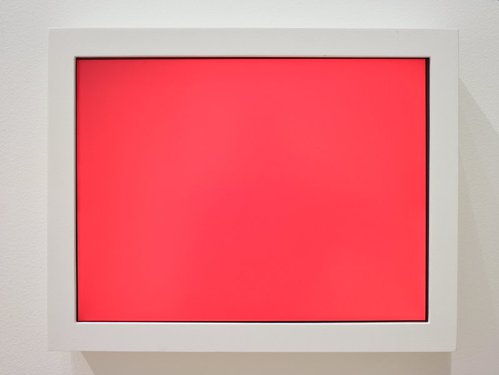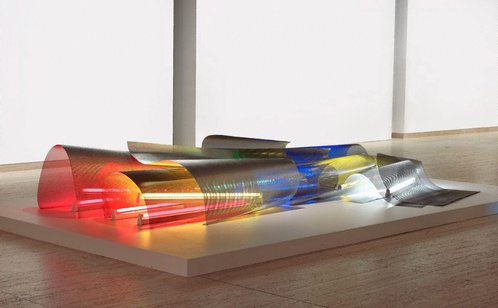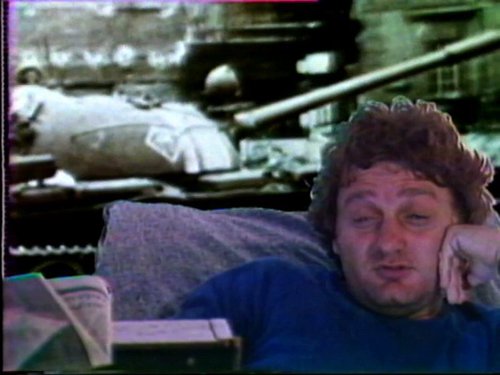Title
Seven people who died the day I was born - April 18, 1945 (part 1)
1997-1998
Artist
-
Details
- Date
- 1997-1998
- Media categories
- Mixed media , Photograph
- Materials used
- type C photographs, fluorescent tubes with text, metal
- Dimensions
-
262.5 x 600.0 cm installed
:
a - Ernie Pyle portrait
b - soldiers, small
c - Hannie Schaft portrait
d - Dr Lisso and family
e - Ernie Pyle multiple
f - soldiers, large
g - Hannie Schaft multiple
h - fluorescent tube, 122 x 3.8 cm
i - fluorescent tube, 122 x 3.8 cm
j - fluorescent tube, 122 x 3.8 cm
k - fluorescent tube, 122 x 3.8 cm
l - fluorescent tube, 122 x 3.8 cm
m - fluorescent tube, 122 x 3.8 cm
n - fluorescent tube, 122 x 3.8 cm
o - fluorescent tube, 122 x 3.8 cm
p - fluorescent tube, 122 x 3.8 cm
q - fluorescent tube, 122 x 3.8 cm
r - fluorescent tube, 122 x 3.8 cm
s - fluorescent tube, 122 x 3.8 cm
t - fluorescent tube, 122 x 3.8 cm
u - fluorescent tube, 122 x 3.8 cm
- Credit
- Contemporary Collection Benefactors 2003
- Location
- Not on display
- Accession number
- 31.2003.a-u
- Copyright
- © Peter Kennedy/Copyright Agency
- Artist information
-
Peter Kennedy
Works in the collection
- Share
-
-
About
Peter Kennedy was a founding member of the Inhibodress artists’ space in Woolloomooloo, Sydney, a key venue for experimental art in the early 1970s. Kennedy has subsequently developed a politically reflective artistic practice grounded in conceptual art, but which has aimed to be ‘accessible either intellectually or emotionally’.1 His installations usually include evidence of the process of devising the work in the final exhibition in order to show his thinking and the artwork’s development, while his use of an expressive ‘language’ embodies his intention to create an accessible and democratic avant-garde.
‘Seven people who died the day I was born – April 18, 1945 (part 1)’ is from a series Kennedy began in 1997 after his father’s death and which considers the interconnectedness of individual lives and political and historical events. It was originally shown in ‘Requiem for ghosts’, a solo exhibition at the Australian Centre for Contemporary Art in 1998, which brought together the names and images of people who either died or were born on the day that Kennedy was born, 18 April 1945. Kennedy’s birth in the last year of World War II sits at a pivotal point in 20th-century history. The work embeds this moment in a web of connections between lives that ended as Kennedy’s life began and through which a very personal moment is invested with political resonance. His generation grew up with intense personal remembrances from fathers, mothers and others whose lives had been changed in ways unimaginable to other generations. In this work he reflects on his own mortality, acutely aware that this direct link to that history is slipping away.
‘I was constantly reminded, in constructing the two parts of “People who have Died the Day I was Born”, that those people who have lived through the events of the first part of this century now have a tenuous hold on the present, and that the clasp will soon be broken. At that point the contact we now have with living memory will be cancelled and we will be left to negotiate our own contracts with the past ...’
The structure of this work reflects strategies in conceptual art, particularly the installational role of photography after minimalism. John Baldessari and Jochen Gerz realised the potential of photo-graphs to extend associations and readings by multiple juxtapositions. This has to be seen as differing from the idea of a linear narrative (such as a picture book or cartoon); this is why the minimalist structure that determines the relationships of the individual images is so crucial in making this an accumulative association with no limit. There are seven people memorialised here but of course they imply the many others who also died. The text that identifies the dead takes the form of a central line from which the images are hinged above and below. The line is made of fluorescent tubes – a gentle reference to minimalist artist Dan Flavin perhaps but it also carries a trace of bunkers or institutional and archival spaces.
1. Peter Kennedy quotes from ‘Peter Kennedy: poetics, politics & a silent music’, interview by Anne Marsh, Globe, www.arts.monash.edu.au/visarts/globe/issue8
© Art Gallery of New South Wales Contemporary Collection Handbook, 2006
-
Exhibition history
Shown in 4 exhibitions
Requiem for ghosts, Australian Centre for Contemporary Art, South Bank, 1998–1998
Zeitgenössische Fotokunst aus Australien, Städtische Kunstsammlungen Chemnitz, Germany, 2000–2000
Zeitgenössische Fotokunst aus Australien, Neuer Berliner Kunstverein, Berlin, 2000–2000
Zeitgenössische Fotokunst aus Australien, Museum Schloß Hardenburg, Velbert, Germany, 2000–2000
Zeitgenössische Fotokunst aus Australien, Kulturzentrum der Stadt Stuttgart, Stuttgart, 2000–2000
Peter Kennedy, selected works 1970-2002, The Ian Potter Museum of Art, Parkville, 24 Apr 2002–30 Jun 2002
Meridian, Museum of Contemporary Art, Australia, 22 Nov 2002–23 Feb 2003
-
Bibliography
Referenced in 7 publications
-
Anthony Bond, Contemporary: Art Gallery of New South Wales Contemporary Collection, 'Imagining the body', pg.246-289, Sydney, 2006, 270, 271 (colour illus.).
-
Juliana Engberg, Requiem for ghosts, '...And...', Melbourne, 1998.
-
Anne Marsh, Peter Kennedy, selected works from 1970 to 2002, 'Peter Kennedy: an avant-garde practice', Melbourne, 2002.
-
Margaret Plant, Meridian, 'Peter Kennedy', pg.74-79, Sydney, 2002, 76 (colour illus.).
-
Nancy Underhill, Art and Australia (Vol. 38, No. 1), 'Peter Kennedy: breaking down the barriers', pg.98-103, Sydney, Sep 2000-Nov 2000, 98-103.
-
Editor Unknown (Editor), Signs of life: Melbourne International Biennial 1999, Melbourne, 1999, 112.
-
Editor Unknown (Editor), Zeitgenössische Fotokunst aus Australien, Heidelberg, 2000.
-




